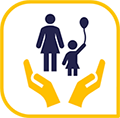1.2. Women and girls in the context of displacement

Women and girls throughout the world may be subjected to intense forms of cultural, structural and direct violence. Gender-based violence may include – but is by no means limited to – sexual abuse and exploitation, rape, female genital mutilation/cutting (FGM/C), human trafficking, harassment and domestic violence, as well as social stigmatisation and marginalisation.
Gender-based violence may be the key reason for having to flee the country of origin but may also be experienced during the journey through transit countries in the pursuit of safety. Accordingly, such experiences need to be included in the development of protection solutions in receiving countries to sufficiently cater to the needs of survivors of gender-based violence.
In 2022, a number of reports highlighted how women and girls are disproportionally affected in displacement situations. Relevant initiatives were launched by various stakeholders to increase understanding of the gender dimension in the context of displacement and enhance capacity to address gender-related considerations in international protection processes.
In the context of South America, Amnesty International reported on the daily discrimination and direct violence that Venezuelan refugee women and girls faced in public and private spaces in the host country – including within their families and workplaces – due to their gender and nationality. The report indicates that Colombia and Peru fell short of ensuring protection to these women, without effective access to the asylum procedure and to justice and health systems for survivors of gender-based violence.45
The International Rescue Committee analysed that the extreme drought in east Africa led to increased violence against women and girls, including in refugee camps. Combined with the economic downturn resulting from the COVID-19 pandemic, the drought forced women, who are in charge of providing food and water to their families, to travel further from home in search of provisions, thus being exposed to higher risks. As families migrate in search of resources, children – especially girls – are dropping out of school and in unfamiliar and risky territories.46
CARE published a brief on the link between food insecurity and gender-based violence, which is also catalysed by other parameters, such as discriminatory social norms, environmental degradation and a lack of income opportunities. Examples were given of cases in Afghanistan, Bangladesh, Burundi, the Central African Republic, Ethiopia, Rwanda and Somalia.47 In Somalia, CARE’s research indicated a staggering 200% increase in violence against women and girls between 2021 and 2022, particularly intimate partner violence and rape.48
It is fundamental that gender considerations are integrated into the asylum procedure, even when a specific asylum claim is not clearly gender-related per se. A number of regional and national legal instruments are in place to safeguard the rights of women and girls, and prohibit social, cultural and religious practices that may be harmful to them.
Apart from gendered analysis for a better understanding of the gender dimension in the provision of protection solutions, key recommendations and guidance produced in 2022 stressed the importance of including a gender perspective in asylum procedures. In May 2022, the Committee of Ministers of the Council of Europe adopted a new recommendation on the protection of rights for migrant, refugee and asylum-seeking women and girls. The recommendations define measures to better respond to their needs and the challenges faced by them.49
To foster integration prospects in host societies, the ‘WorldPlaces’ project developed a toolkit for the meaningful engagement of migrant, asylum-seeking and refugee women at the workplace.50 The project involves national partners from a number of countries and European-wide organisations, such as the European Network of Migrant Women.
- 45Amnesty International. (2022, July 12). Colombia and Peru: Abandoned by the state in host countries, Venezuelan women face increasing gender-based violence. https://www.amnesty.org/en/latest/news/2022/07/colombia-peru-venezuelan-women-face-gender-based-violence/
- 46International Rescue Committee. (June 2022). New IRC data: Horn of Africa drought leading to increasing violence against women and girls. https://www.rescue.org/press-release/new-irc-data-horn-africa-drought-leading-increasing-violence-against-women-and-girls
- 47Care International. (November 2022). Gender-based violence and food insecurity: What we know and why gender equality is the answer. https://www.care.org/wp-content/uploads/2022/11/GBV-food-security-brief_EN.pdf
- 48Care International. (2022, October 14). Somalia: Women and girls left vulnerable in worsening drought. https://www.care-international.org/news/somalia-women-and-girls-left-vulnerable-worsening-drought
- 49Council of Europe. (2022, May 20). Protecting rights of migrant, refugee and asylum-seeking women and girls: Council of Europe recommendation adopted. https://www.coe.int/en/web/portal/-/protecting-rights-of-migrant-refugee-and-asylum-seeking-women-and-girls-council-of-europe-recommendation-adopted
- 50European Network of Migrant Women. (October 2022). Toolkit: Meaningful engagement and integration of migrant women. https://www.migrantwomennetwork.org/2022/10/15/worldplaces-toolkit-meaningful-engagement-migrant-women/

